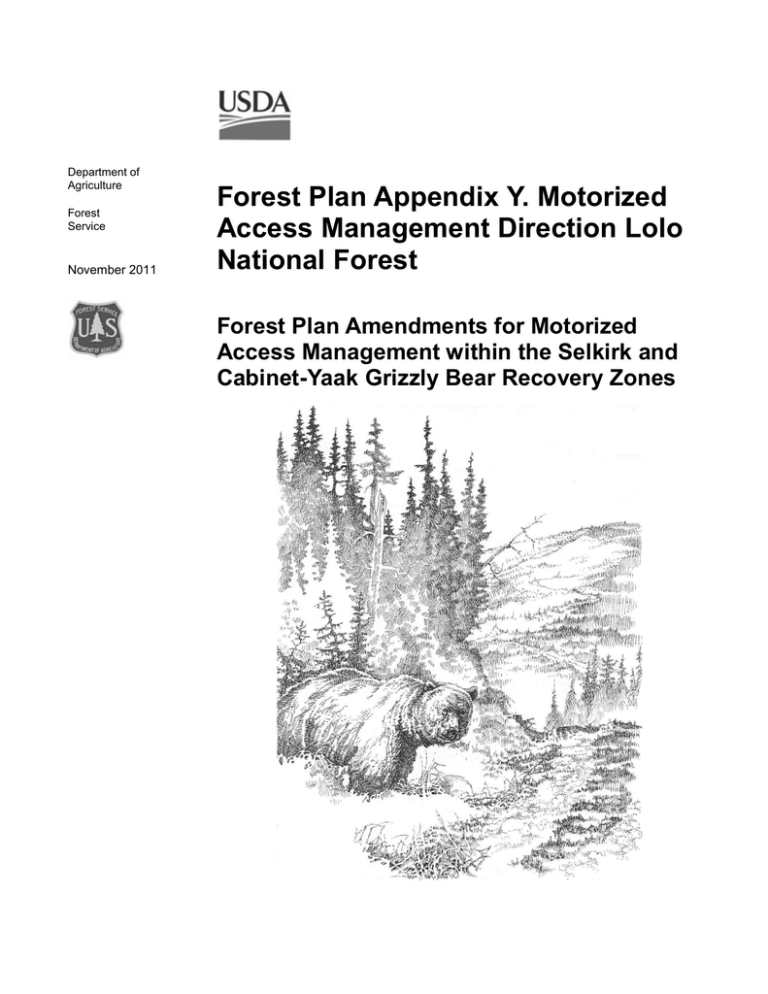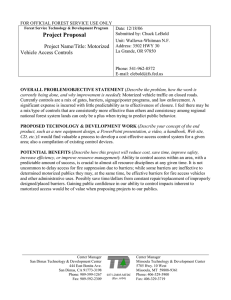Forest Plan Appendix Y. Motorized Access Management Direction
advertisement

Department of Agriculture Forest Service November 2011 Forest Plan Appendix Y. Motorized Access Management Direction Lolo National Forest Forest Plan Amendments for Motorized Access Management within the Selkirk and Cabinet-Yaak Grizzly Bear Recovery Zones Appendix Y. Motorized Access Management Direction Lolo National Forest Appendix Y. Motorized Access Management Direction Replace the Forest Plan standards for Linear Open Road Density and Habitat Effectiveness with the following. Design Elements I. The following access management standards would apply to individual BMUs within the CabinetYaak Recovery Zone on the LNF: A. The OMRD, TMRD, and percent core standards displayed in Table 1 would be established for the BMUs in the Cabinet-Yaak Ecosystem. B. Parameters for establishing and managing core habitat in all BMUs: 1. In accordance with IGBC (1998) and Selkirk/Cabinet-Yaak Ecosystem Subcommittee (1998) direction, core areas shall be established for the purpose of providing secure habitat for grizzly bears. a. Core areas include high quality habitat within a BMU that contains no motorized travel routes or high use trails. b. Core areas do not include any gated or restricted roads but may contain roads that are impassable due to re-growth of vegetation, effective barriers other than gates, or placement of logging or forest debris so as to no longer function as a motorized route. c. When possible, core areas would be delineated by identifying and aggregating the full range of seasonal habitats that are available in the BMU. d. The IGBC anticipated that minimum core area size might be determined for each recovery zone. For the Selkirk/Cabinet-Yaak Grizzly Bear Recovery Zones, no scientifically based minimum effective size polygon for core area has been determined (Wakkinen and Kasworm 1997), though minimum block sizes of 2-8 mi2 were suggested. Therefore, discounting small or narrow blocks of core area is not prudent at this time. Individual project analyses would disclose the percent and size of core areas in each BMU. e. Once route closures to create core areas are established and effective, these core areas should remain in place for at least 10 years. Therefore, except for emergencies or other unforeseen circumstances requiring independent section 7 consultation, newly created core area shall not be entered for at least 10 years after creation. f. Roads that are closed, decommissioned, or barriered in the future to create core area would be put in a condition such that a need for motorized access for maintenance is not anticipated for at least 10 years. Until such closed roads are placed in the above-described condition, they would not be considered as contributing to core area. 2. Entering core area blocks for road decommissioning or stabilization activities: Forest Plan Amendments for Motorized Access Management within the Selkirk and Cabinet-Yaak Grizzly Bear Recovery Zones 2 Appendix Y. Motorized Access Management Direction Lolo National Forest a. Without further section 7 consultation on grizzly bears, the Forest Service may affect underlying core area habitat within a BMU once per 10-year time frame for the sole purpose of completing road decommissioning/stabilization activities on existing closed or barriered roads in core habitat. b. Subsequent needs to re-enter individual core areas within a BMU more frequently than once per decade for the purposes of road decommissioning shall be handled on a case-bycase basis through standard section 7 consultation procedures. The effects of additional entries would be analyzed pursuant to such project level consultation. Pending the outcome of each analysis, additional measures to minimize potential effects to grizzly bears may be required. 3. Routine forest management may be proposed in a core area block after 10-years of core area benefit. However, BMUs must remain at or above the core standard. Therefore, potential losses to existing core must be compensated with in-kind replacement concurrently or prior to incurring the losses. Such in-kind replacement of core would be established within the affected BMU in accordance with the direction in Part I.B.1., above. For exceptions, see specialized circumstances outlined in Part I.D. concerning BMUs that exceed standards. Following management, core areas must subsequently be managed undisturbed for 10 years. C. Parameters for BMUs currently not meeting core area, OMRD, and/or TMRD standards: 1. These BMUs are anticipated to be brought up to standards in the following manner: 33 percent of those BMUs currently not meeting one or more standard within each ecosystem are estimated to meet all standards within three years of the amendment decision date; 66 percent of those BMUs currently not meeting one or more standard within each ecosystem are estimated to meet all standards within 5 years of the amendment decision date, and 100 percent of those BMUs currently not meeting one or more standard within each ecosystem are estimated to meet all standards within eight years of the amendment decision date. D. For those BMUs currently meeting or exceeding (being better than) the standards for core area: 1. Except as provided above for road stabilization projects, no reductions in core habitat without in-kind replacements would be proposed until all BMUs administered by the IPNF, KNF and LNF in the respective ecosystems are up to standard (Table 1). 2. Once all BMUs meet all standards then subsequent projects that propose to permanently reduce core area by roads shall undergo independent section 7 formal consultation. 3. Reductions of core area within individual BMUs shall not reduce the percent core area below the minimum standards for the affected BMU without compensating with in-kind replacement concurrently or prior to incurring the losses (see Part I.B.3.). E. Road use associated with completing administrative activities: 1. In the Cabinet-Yaak Ecosystem: a. Administrative use shall not exceed 60 vehicle round trips per active bear year per road, apportioned as follows: ≤18 round trips in spring (April 1 through June15); ≤23 round trips in summer (June 16 through September 15); and ≤19 round trips in fall (September 16 through November 30). Forest Plan Amendments for Motorized Access Management within the Selkirk and Cabinet-Yaak Grizzly Bear Recovery Zones 3 Appendix Y. Motorized Access Management Direction Lolo National Forest b. If the number of trips exceeds 60 trips per active bear year in the Cabinet-Yaak ecosystem, then that road would be considered "open" for analysis and reporting purposes. Likewise, if the number of trips exceeds the allowable ecosystem-specific seasonal (spring, summer, and fall) vehicle round trips per road, then that road would be considered "open" for analysis and reporting purposes. II. To ensure the effective implementation of the open road density parameter, at least 30 percent of closure devices (gates and barriers) will be monitored annually within the Cabinet-Yaak ecosystem. Monitoring techniques may include visual checks as well as road counters. Table1. LNF BMU status and standards 2 BMU 22Mt.Headley BMU Priorities 3 OMRD >1mi/mi (percent) 2009 Status Proposed Standard (max) 38 17 2 Core Area (percent) TMRD >2 mi/mi (percent) 2009 Status Proposed Standard (max) 2009 Status Proposed Standard (min.) 37 14 51 72 Forest Plan Amendments for Motorized Access Management within the Selkirk and Cabinet-Yaak Grizzly Bear Recovery Zones Percent NFS Land 89 4
